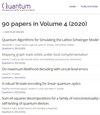通过伪乔伊状态的影子断层扫描进行哈密顿学习
IF 5.1
2区 物理与天体物理
Q1 PHYSICS, MULTIDISCIPLINARY
引用次数: 0
摘要
我们引入了一种新的方法来学习哈密顿量通过一个资源,我们称之为伪崔状态,它编码哈密顿量在一个状态使用一个类似于Choi-Jamiolkowski同构的过程。我们提供了一种有效的方法,通过查询形式为$e^{-iHt}$及其逆的时间演化酉元来生成这些伪choi状态,并表明对于具有$M$项的哈密顿量,哈密顿系数可以通过使用$\widetilde{O}\left(\frac{M}{t^2\epsilon^2}\right)$查询状态准备协议,在$2$ -范数的误差$\epsilon$内通过经典阴影层扫描来估计,其中$t \le \frac{1}{2\left\lVert H \right\rVert}$。我们进一步展示了一种替代方法,该方法避开了经典的阴影断层扫描,支持量子平均估计,将该成本(以更多量子比特的代价)降低到$\widetilde{O}\left(\frac{M}{t\epsilon}\right)$。此外,我们表明,在没有访问状态准备协议的情况下,可以使用$\widetilde{O}\left(\frac{\alpha^4M}{\epsilon^2}\right)$伪choi状态的副本来学习哈密顿量。常数$\alpha$取决于哈密顿量的范数,如果使用规格化哈密顿量的伪choi状态,则可以二次改进以$\alpha$表示的缩放。最后,我们证明了我们的学习过程对资源状态和哈密顿类的误差具有鲁棒性。具体来说,我们表明,如果真正的哈密顿函数包含的项比我们认为在重构中存在的项更多,那么我们的方法给出了一个指示,即存在尚未被识别的哈密顿函数项,并且仍然可以准确地估计哈密顿函数中的已知项。本文章由计算机程序翻译,如有差异,请以英文原文为准。
Hamiltonian Learning via Shadow Tomography of Pseudo-Choi States
We introduce a new approach to learn Hamiltonians through a resource that we call the pseudo-Choi state, which encodes the Hamiltonian in a state using a procedure that is analogous to the Choi-Jamiolkowski isomorphism. We provide an efficient method for generating these pseudo-Choi states by querying a time evolution unitary of the form $e^{-iHt}$ and its inverse, and show that for a Hamiltonian with $M$ terms the Hamiltonian coefficients can be estimated via classical shadow tomography within error $\epsilon$ in the $2$-norm using $\widetilde{O}\left(\frac{M}{t^2\epsilon^2}\right)$ queries to the state preparation protocol, where $t \le \frac{1}{2\left\lVert H \right\rVert}$. We further show an alternative approach that eschews classical shadow tomography in favor of quantum mean estimation that reduces this cost (at the price of many more qubits) to $\widetilde{O}\left(\frac{M}{t\epsilon}\right)$. Additionally, we show that in the case where one does not have access to the state preparation protocol, the Hamiltonian can be learned using $\widetilde{O}\left(\frac{\alpha^4M}{\epsilon^2}\right)$ copies of the pseudo-Choi state. The constant $\alpha$ depends on the norm of the Hamiltonian, and the scaling in terms of $\alpha$ can be improved quadratically if using pseudo-Choi states of the normalized Hamiltonian. Finally, we show that our learning process is robust to errors in the resource states and to errors in the Hamiltonian class. Specifically, we show that if the true Hamiltonian contains more terms than we believe are present in the reconstruction, then our methods give an indication that there are Hamiltonian terms that have not been identified and will still accurately estimate the known terms in the Hamiltonian.
求助全文
通过发布文献求助,成功后即可免费获取论文全文。
去求助
来源期刊

Quantum
Physics and Astronomy-Physics and Astronomy (miscellaneous)
CiteScore
9.20
自引率
10.90%
发文量
241
审稿时长
16 weeks
期刊介绍:
Quantum is an open-access peer-reviewed journal for quantum science and related fields. Quantum is non-profit and community-run: an effort by researchers and for researchers to make science more open and publishing more transparent and efficient.
 求助内容:
求助内容: 应助结果提醒方式:
应助结果提醒方式:


